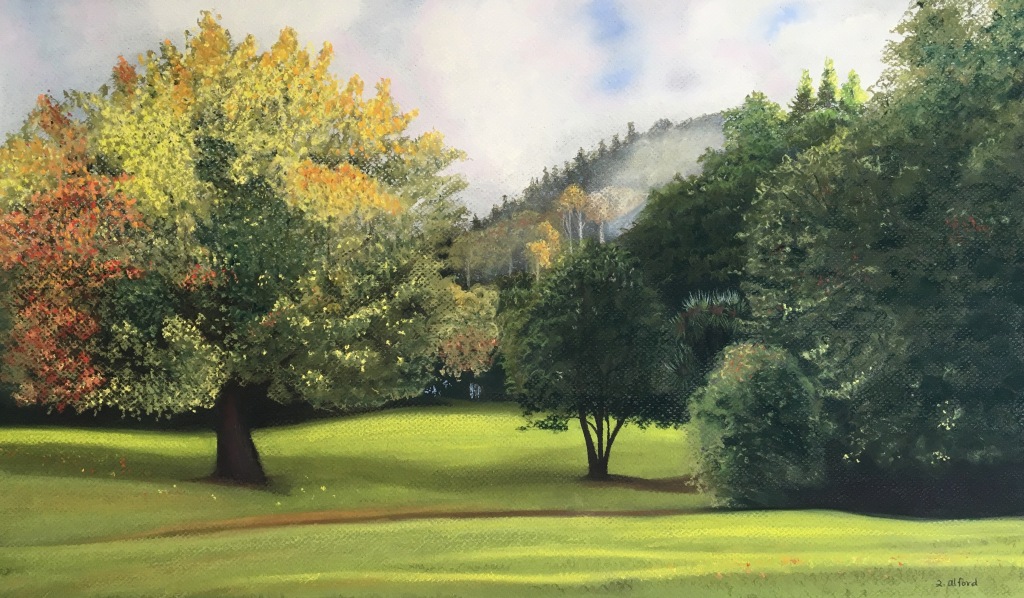Words: Mrs Darling

Being in the middle of winter, but feeling like spring is coming, is like being stuck in a traffic jam, but your favourite song is playing on the radio.
We’re just past the middle of winter (23 July). It’s been a beautiful day, even quite warm once the sun was high enough in the sky. I put out three loads of washing then spent the rest of the day in the glasshouse. It was so warm in there the auto-vents were wide open. I had my iPods in, listening to a playlist of my favourite songs and really feeling as if spring was just around the corner. Well it’s a bit further down the road than that. But not too far – it’s actually only 5 weeks away. At my age that’ll flash by in a nanosecond.
So far this winter, we haven’t had a frost at our place. Not having one all winter has never happened in the more than 30 years we’ve lived here, so it doesn’t surprise me to find out (Met Service app on my phone) that it’s going to get pretty close to a frost tonight – down to 4 degrees C. That’s cold enough for the heater in the glasshouse to turn itself on which is a Very Good Thing because I need it to keep my plants reasonably snug. I’ve got seeds in punnets and pots and tender lettuces in the beds. The punnets and pots are all sitting on the heat pad though. I’ve planted tomatoes (Early Girl and Sweet 100s), cucumbers, butternut pumpkins, zucchinis and basil. I think the heat pad has a slightly warming effect on the glasshouse, but I can’t be sure. In any case, the seeds will be warm as.

In the picture above you can see a couple of tomato plants (back left). They’re self-seeded Sweet 100s from the legendary plant I pulled out last month. It produced thousands of tomatoes for 3 years and took over the entire glasshouse. I’ll plant these ones outside at Labour Weekend (21/22 October). They’ll be big and strong by then. I’ll put one Early Girl in the glasshouse, and the rest can also go outside.
My friend Colin “Bruiser” Smith sent me a photo of his tomato seedlings yesterday. They’re up to their second leaves. He’s probably a full month ahead of me. Not that it’s a competition, of course (*cough). I’d only really be competitive with him in my dreams. He had 80kgs of tomatoes in his freezer by the end of April, a lot of them grown in his glasshouse. Check out his marvellousness here when he did a guest post for me.
Last month I told you I’d planted some bean seeds, but none had germinated. I was pretty sure they wouldn’t come up at all. I was wrong (incredibly rare): they DID come up. That shows you how warm the soil is in the glasshouse because they need at least 15 degrees C to germinate. The beds in the glasshouse are slightly raised too and that makes a difference. Jo McCarroll, in the July issue of New Zealand Gardener magazine, wrote that she’d bought a soil thermometer and found the soil in her raised beds was 7 degrees C warmer than the ground, and the soil in her pots warmer still.

Yesterday I went to Mitre 10 with Dr Darling to buy a soil thermometer and came home with a pH- and moisture-probe instead. And some seedlings I hadn’t planned to buy (sugar snaps and lettuces – all now planted in the glasshouse). And some seeds for very pretty blue daisies. And some spraying oil.
The best part of going to Mitre 10 was checking out. On previous trips there Dr Darling would whip out his Airpoints card at the checkout, even if I was paying the bill, knowing I don’t carry mine. However, when I’d gone to Mitre 10 on my own a few days earlier (seeds, potting mix, punnets of irresistible seedlings), and the woman at the check out asked me if I had an Airpoints card, and I said “not with me, no”, she then asked if I had the Air NZ app on my phone. Well yes I did. She then showed me where to find the barcode for my Airpoints card on the app, scanned it, and sent me on my way. I could hardly wait for the next trip with Dr Darling. When we reached the checkout yesterday, and I was asked for my Airpoints card (I was paying), I saw him reach for his card wallet. With incredible speed (for someone my age), I found the app, brought up the barcode, and had it scanned. He was stunned, and I whooped with delight. Not that it’s a competition, of course. Because he’s such a good sport, he was delighted too, and we laughed all the way back to the car. I know what you’re thinking: that we probably need to get out more. You could be right.








